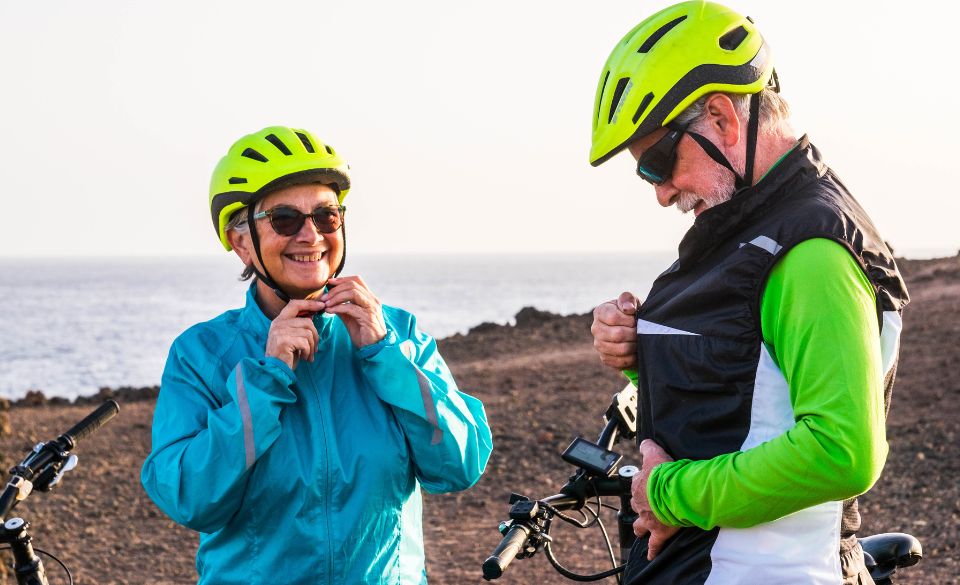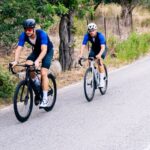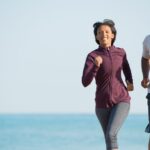
Training for Senior Cyclists – 70 Plus
Page Contents
Welcome to a journey that delves deep into the fascinating world of how aging affects our physical performance. As we navigate the twists and turns of time, our bodies undergo remarkable changes, inevitably leading to a shift in our capabilities.
In our youthful twenties, we experience a peak in physical vitality, a time when we feel invincible. Yet, as we age, a natural decline sets in. This decline is a reality, but it’s a nuanced one, influenced by a multitude of factors.
So, join us on this adventure as we unravel the intricacies of how aging impacts physical performance and discover the wisdom that can help us navigate this journey with grace and resilience. It’s a path where knowledge and choice intersect, offering a future of possibilities.
The Effects of Aging on Physical Performance
Our bodies experience a peak in our 20s, after which a natural decline commences. Although active individuals tend to experience a slower rate of decline, overall, our physical capabilities diminish over time. These changes encompass:
1. Cardiovascular Changes: The heart’s ability to supply oxygen to working muscles decreases due to a reduced maximum heart rate and a decrease in stroke volume (the amount of blood pumped per heartbeat).
2. Muscle Mass Reduction: Muscle mass diminishes as we age. Fast-twitch muscle fibers, primarily engaged in demanding activities such as climbing, deteriorate at a faster rate than slow-twitch fibers. This is because fast-twitch fibers are seldom used in daily activities. Additionally, muscle flexibility and range of motion decrease. Fortunately, the remaining muscles maintain their ability to process oxygen and generate power.
3. Respiratory Changes: Aging brings reduced lung tissue elasticity and increased airway resistance, resulting in a decline in maximal expiratory ventilation.
4. Metabolic Changes: The dissipation of lactic acid, produced during anaerobic activities, is slower in older individuals. This makes it more challenging to sustain high-intensity efforts.
5. Heat Tolerance: Older cyclists often have a reduced tolerance for extreme heat and exhibit diminished sweating in hot, dry conditions.
6. Fluid Balance: Older individuals produce more urine during exercise, leading to reduced blood volume and more frequent breaks from physical activity.
7. Immune System Weakening: The aging process weakens the immune system, rendering older riders more susceptible to ailments such as colds and overtraining.
While some performance decline is an inevitable aspect of aging, studies comparing active and inactive individuals reveal that much of the age-related slowdown is influenced by personal choices.
Approximately half of the decline in physical performance can be attributed to inactivity, with another quarter being the result of reduced training intensity. Consequently, the key to preserving vitality is to engage in frequent and high-intensity riding.
For instance, a study involving active racers demonstrated that 40-kilometer time trial performances only declined by an average of 20 seconds per year after reaching the age of 35 (Friel, J., Cycling Past 50, Champaign, IL, 1998, pp. 4-17).
Training the Aging Body: A Guide
Training effectively as an older rider requires a specific approach. The following principles should serve as your guidelines:
1. Consistent Training: Given the natural decline in fitness components with age, it’s imperative to maintain a consistent training regimen throughout the year. Inactivity accelerates the loss of fitness, so you can’t afford extended periods of downtime.
2. Adequate Rest: Rest and recovery are fundamental aspects of training for riders past the age of 50. As mentioned by Friel, “the most important pieces of the training puzzle for the serious past-50 rider are rest and recovery.” Getting enough rest can be a challenge. The body primarily produces human growth hormone (HGH) during sleep, which is essential for muscle repair and growth. As HGH production diminishes with age, it’s crucial for serious riders to aim for at least eight hours of nightly sleep, supplementing it with a short nap if necessary.
3. Full Recovery: Allowing sufficient time between demanding rides is crucial. Unless there’s a specific training purpose, such as simulating a tour, it’s recommended to have 48 to 72 hours of recovery between challenging rides.
Aim for a maximum of three hard rides a week, encompassing an endurance ride (where conversation is easy), a tempo ride (where you can talk but not whistle), and an intensity ride (intensity varies based on your goals).
The other four days should be allocated to active recovery or rest. Incorporate easier recovery weeks every other week or every fourth week, with reduced volume compared to the preceding week. Complete breaks of one week are also advisable.
4. Moderate Workouts: Your training should be designed to promote improvement without excessive fatigue. The objective is to maximize progress, not to induce excessive weariness.
5. Frequent Exercise: Studies indicate that if you already possess high aerobic fitness, riding four days a week is adequate to maintain it. However, for those aiming to improve, riding five to six days per week yields the fastest progress.
6. Target Weaknesses: Time is precious for older athletes, and it’s essential to use it wisely. Focus your limited training time on addressing your specific weaknesses.
7. Intensity Matters: According to Friel, the intensity of your riding is the single most critical factor. The most substantial enhancements in aerobic capacity are achieved through intense riding.
8. Moderate Eating: As your metabolism naturally slows with age, you expend fewer calories in daily activities. Sedentary individuals often gain weight as they grow older. Even active individuals may experience increased body fat. Therefore, it’s vital to manage your calorie intake.
9. Skill Practice: Aging introduces physiological changes, necessitating a more strategic approach to riding. For instance, consuming 200-300 calories every hour during rides prevents energy depletion, and drinking just enough to quench your thirst is crucial. As fatigue sets in, ingrained habits become more prevalent. Consequently, your training rides should focus on establishing the habits you’ll require during events.
10. Stress Management: The risk of overtraining is amplified by various external stresses, such as family commitments, work pressures, and career expectations. Serious training is just one component of the broader stress landscape that can lead to overload and physical breakdown.
11. Diversify Your Training: To counteract muscle loss and reduced flexibility that comes with age and inactivity, incorporate weight-bearing activities, general strength exercises, core workouts, and stretching into your program.
12. Effective Tapering: Adequate rest is not only essential during training but also critical before an event. It ensures that you arrive at the starting line feeling fresh and prepared. Friel emphasizes that once a rider reaches the desired fitness level, reducing weekly mileage and ride frequency won’t lead to a performance decline. However, a decrease in intensity will result in a decrease in performance.
By adhering to these guidelines, older riders can optimize their training and achieve lasting success on the road.
Key Cycling Workouts For 70+ Year Olds
Here are some cycling workouts based on the principles we just discussed.
1. Endurance Ride (60-90 minutes):
Purpose: Build aerobic endurance and stamina.
Description: Maintain a steady pace where you can easily hold a conversation. Focus on pedaling efficiency and keeping a consistent rhythm.
2. Tempo Ride (45-60 minutes):
Purpose: Improve your ability to sustain a moderately hard effort.
Description: Ride at a pace where talking is still possible but requires a bit more effort. This should feel challenging but sustainable.
3. Intensity Ride (30-45 minutes):
Purpose: Enhance your high-intensity capabilities.
Description: The intensity of this ride depends on your specific goals. You can incorporate intervals at higher effort levels, such as sprints, hill climbs, or fast-paced segments. Push yourself close to your limit during these intervals but maintain good form and safety.
4. Active Recovery (30-60 minutes):
Purpose: Promote recovery and active rest.
Description: Ride at a very easy pace, focusing on smooth pedaling and low effort. Use this as a restorative ride to aid recovery between more challenging workouts.
5. Rest Day (0 minutes on the bike):
Purpose: Full rest and recovery.
Description: On these days, avoid cycling altogether. Let your body recuperate, repair, and prepare for the next training session. Engage in non-cycling activities or simply relax.
6. Long Endurance Ride (2-4 hours, once a week):
Purpose: Enhance your endurance capacity for longer rides.
Description: Choose one day each week for a longer ride at an easy endurance pace. The emphasis here is on distance and time rather than speed.
7. Hill Training (45-60 minutes, once a week):
Purpose: Improve strength and climbing abilities.
Description: Find a hilly route or use a stationary bike with resistance. Alternate between periods of climbing at higher resistance and descending or riding on flat terrain. Adjust the intensity to align with your goals.
Remember that the key to successful cycling training is to listen to your body. Adjust the intensity and duration of these workouts based on your fitness level and how your body responds. Gradually progress over time to prevent overtraining and ensure you’re continually challenging yourself without risking injury or burnout.
Final Words – Training for Senior Cyclists – 70 Plus
In conclusion, the journey of aging is an intricate and inevitable one, marked by a transformation in our physical performance. While time may bring about a natural decline in our capabilities, it is far from the end of the road. We’ve uncovered the various ways aging affects our bodies, from cardiovascular and muscular changes to shifts in heat tolerance, fluid balance, and the immune system.
What’s heartening is that our choices and actions play a significant role in shaping this journey. Studies have revealed that, while some performance decline is inevitable, much of it can be attributed to lifestyle choices. Inactivity and reduced training intensity contribute to this decline. The road to preserving vitality and physical performance, especially for senior cyclists in their 70s and beyond, hinges on a strategic approach to training.
By adhering to the guidelines outlined in this journey, you have the tools to optimize your training and cycling experience. The principles of consistent training, adequate rest, full recovery, frequent exercise, and targeted training will be your companions on this road. Additionally, the significance of stress management, nutrition, and skill practice in the context of an aging body cannot be overstated.
So, embrace this journey with grace and resilience. The path may be marked by time’s twists and turns, but it’s also paved with wisdom, knowledge, and choices. As a senior cyclist in your 70s and beyond, you have the power to make this journey a remarkable one, filled with possibilities and lasting success on the road. Age may bring change, but it also brings wisdom, experience, and the freedom to cycle through the years with vigor and passion.



